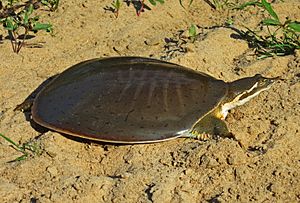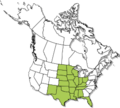Smooth softshell turtle facts for kids
The smooth softshell turtle (Apalone mutica) is a special kind of turtle found only in North America. Unlike most turtles, it has a soft, leathery shell instead of a hard, bony one. It belongs to the Trionychidae family, which includes other softshell turtles.
Quick facts for kids Smooth softshell turtle |
|
|---|---|
 |
|
| Conservation status | |
| Scientific classification | |
| Genus: |
Apalone
|
| Species: |
mutica
|
Contents
- Where Do Smooth Softshell Turtles Live?
- What Kind of Places Do They Like?
- What Do Smooth Softshell Turtles Look Like?
- How Are They Different from Similar Turtles?
- What Do Smooth Softshell Turtles Eat?
- Reproduction and Life Cycle
- How Do Smooth Softshell Turtles Live?
- Are Smooth Softshell Turtles in Danger?
- Images for kids
- See also
Where Do Smooth Softshell Turtles Live?
Smooth softshell turtles are native to North America. You can find them across the central and south-central United States. Their home range stretches from western Pennsylvania all the way to New Mexico, and south to the Florida panhandle.
These turtles live in many river systems, including the Mississippi River and its branches, from Louisiana up to North Dakota and Pennsylvania. They also live in the Colorado, Brazos, Sabine, Pearl, Alabama, and Escambia river systems.
There are two main types, or subspecies, of the smooth softshell turtle:
- The midland smooth softshell (Apalone mutica mutica) lives throughout the central United States.
- The Gulf Coast smooth softshell (Apalone mutica calvata) is found from Louisiana to the Florida panhandle.
What Kind of Places Do They Like?
Both types of smooth softshell turtles usually live in medium to large rivers that are clean and have a steady flow of water. However, they can also be found in still water like lakes, ponds, and marshes.
They prefer water with sandy or muddy bottoms, avoiding rocky areas or places with lots of plants. It's also important for them to have sandbanks nearby, which they use for nesting and resting.
What Do Smooth Softshell Turtles Look Like?
The smooth softshell turtle has a unique skull, which is a very old type of skull structure seen in early reptiles. This skull doesn't have extra openings behind the eye sockets.
Their most noticeable feature is their shell. It's smooth, flexible, and feels like leather. Instead of the hard, bony plates (called scutes) that most turtles have, their shell is covered by skin.
Their belly shell, called a plastron, is light in color (white or gray) and has no markings. You can often see the bones underneath. They also have a snout that looks like a tube with round nostrils.
How Are They Different from Similar Turtles?
It's easy to mix up smooth softshell turtles with spiny softshell turtles (Apalone spinifera) because they look very similar. But there are a few key differences:
- Shell texture: Spiny softshell turtles have a rough shell with small spines along the front edge. Smooth softshell turtles, as their name suggests, have a completely smooth shell without any spines.
- Chin and throat: The smooth softshell turtle has a plain white chin and throat. The spiny softshell turtle has a spotted or splotchy chin and throat.
- Nostrils: The smooth softshell turtle is the only softshell turtle in North America with perfectly round nostrils. All other softshell species have ridges inside their nose that make their nostrils look C-shaped.
What Do Smooth Softshell Turtles Eat?
Smooth softshell turtles are mostly meat-eaters, which means they are carnivores. Their diet mainly includes:
- Aquatic insects (insects that live in water)
- Crayfish
- Fish
- Amphibians (like frogs or salamanders)
Even though they mostly eat meat, they sometimes eat plants too, such as algae, vegetables, fruits, and nuts.
Reproduction and Life Cycle
Smooth softshell turtles usually breed from April to June. Male turtles will mate with more than one female, a system called polygyny. Males actively look for females. If they find a female who is ready to mate, she will stay still while the male approaches. Mating usually happens in deep water.
Females lay their eggs once a year, typically from May to July. They lay between 3 and 28 eggs in a clutch (a group of eggs). They choose sandy areas for their nests, usually within 100 meters (about 330 feet) of water.
The eggs usually hatch 8 to 12 weeks later, most often in August and September. When they hatch, baby turtles weigh about 5.4 grams (0.19 ounces) and have a shell length of about 4 centimeters (1.6 inches).
Male smooth softshell turtles are ready to reproduce when they are about four years old. Females take longer, becoming mature around nine years old.
Female turtles give their babies a good start even before they hatch! They produce a lot of special fats (non-polar lipids) that provide energy for the growing embryos inside the eggs. This energy helps the embryos survive and gives them a food source until they hatch and can start finding their own food. This is a type of parental care that happens during the embryo's development. However, once the babies hatch, the parents do not provide any physical care.
How Do Smooth Softshell Turtles Live?
Smooth softshell turtles are known as "swimmers" because they spend most of their time in the water. They are very good at staying underwater for a long time. They have a long neck and a special snout that helps them breathe.
Often, they will bury themselves in the sand or mud at the bottom of a river or pond, just deep enough so that their snout can reach the surface to breathe. Their skin, which covers their soft shell, is also very good at taking in oxygen from the water. This helps them stay submerged for long periods. While buried, they often wait patiently for prey to swim by, then use their long neck to quickly grab their meal.
These turtles hibernate during the colder months, from October to March. They do this by burying themselves in the mud or sand underwater. After winter, they come out and are often seen basking in the sun on land. Because their shell is soft, they can't stay in the sun for too long.
When they are basking, they are always alert to their surroundings. If they sense any danger, they quickly dive back into the water to find safety. Their speed and agility both on land and in water make it hard for predators like raccoons, alligators, and snapping turtles to catch them. They hide from threats by diving and burying themselves in the mud.
Are Smooth Softshell Turtles in Danger?
Currently, the smooth softshell turtle is considered a species of "least concern" for conservation. This means they are not immediately in danger of disappearing.
However, they still face some challenges:
- Habitat loss: Their homes are sometimes damaged or destroyed.
- Harvesting for food: In some places, people catch them for food.
- Human disturbance: People can disturb their nesting sites, which makes it harder for them to lay eggs safely.
- Water pollution: Because their skin is so good at exchanging gases with the water, they are very sensitive to polluted water. Dirty water can harm them easily.
Because of these issues, the smooth softshell turtle is listed as a species of "special concern" in states like Minnesota and Wisconsin. This means that while they are not endangered, they need careful monitoring and protection to ensure their populations stay healthy.
Images for kids
See also
 In Spanish: Tortuga de Caparazón Blando Lisa para niños
In Spanish: Tortuga de Caparazón Blando Lisa para niños





